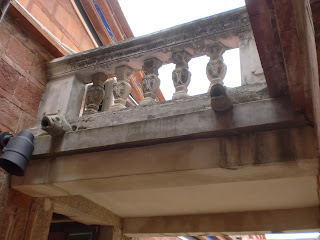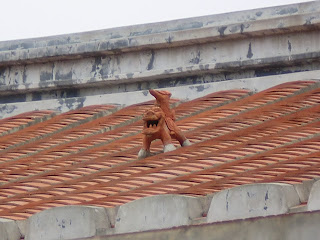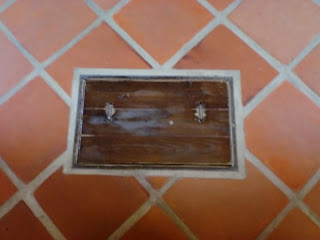先週は華語中心の休みが有って、五日間金門に行って来た。
まずは、発音から始めよう。「金門」って何と発音すればいいだろう?北京語なら、「ジンメン」に近い。でもなぜならば、日本の旅行本とかではよく「チンメン」と言うルビが振っている。日本人はその方がウケるからかな?でもそこに住んでいる人達は元々閩南語を喋っているので、閩南語の発音に直したら、「キモイ」に成る。これもまたウケるね。
では、笑いを堪えて進みましょう。
金門はどこ?
実は、めっちゃ中国に近い。マジで。金門から中国が見えるぞ!金門とその隣りの「小金門」は唯一中華民国(台湾)が支配している福建省の領土だ。福建省は金門と小金門以外全てが共産党の中華人民国の手に落ちた。
金門は完全に台湾より大陸に近いから、離島と言うのはちょっとふさわしくない。でも大陸と金門の政府が異なっているから、金門は遠く離れた台湾と政治的に繋がっている。ある意味では離島に成っている。台湾から金門に行くと、離島に行っている様な気分で飛行機に乗って行く事に成る。
We had a two-week vacation at the language center, so I took a five-day trip to Quemoy.
The name "Quemoy" should trigger an some memories in the baby boomer crowd. In fact, some of you may be feeling slightly nauseated at this point. It's ok, it's normal; it's just because those memories are connected to Nixon, a known cause of nausea. That's right, Quemoy is that place that came up in the 1960 presidential election because those dirty reds were trying to take it from Free China.
But where is Quemoy?
Well, check out this map on the Wikipedia article to see where it is. Now you can see why the Communists tried to take the island, and why the fighting was so heavy. The island is just off the coast of China. It's the sole remaining piece of Fujian Province that is still in the hands of the Republic of China (Taiwan, or "Free China" in 1960's parlance). The rest of Fujian Province is controlled by the People's Republic of China centered in Beijing.
Now, as to the name. You may have noticed in the Wiki article that they mention that the island has multiple names: Kinmen, Quemoy, Chinmen, Jinmen. This is because romanization in Taiwan still has a lot of holdovers from previous systems of romanizing Mandarin, but in the case of "Quemoy" it's because the name isn't even based on Mandarin, it's based on the local, Minnan name. I choose to call the island Quemoy because it is by far the most kickin'-rad of all the choices available.
最近華語中心有兩個禮拜的放假所以我去金門5天玩玩了。因為離臺灣島蠻遠,所以我覺得很多臺灣人沒去過金門。你們得去啦!金門真的很好玩!
金門也有很多福建式的民家,也有很多中國內戰的古跡。還有金門島的人口不太多,所以也有漂漂亮亮的自然。
空港から出て、バス亭を探したら、最初に見た事はこれだ:I stepped out of the airport into the cool(er than Tainan) air of Quemoy and found the bus stop. I was just in time to see them taking away the seats on a truck for some reason. Uh...is this the right place? This is an active bus stop, right?
出了幾場去,找公車站的時候,這些人在把椅子搬到車子後面去。為甚麼!?我想坐下來唷!
椅子をなぜか外していた。
その後港に行って、友達と合流した。そこにこの記念額が有った:
I took a bus to the ferry terminal where I met up with my friend. On our way to the B&B we were staying in, I noticed this plaque near the terminal:
我出幾場,坐公車到港去了。在那裡有一個紀念牌:
中国の内戦の時、アメリカは国民党と協力した。
I'm sure that America's help during the Chinese Civil War is a big part of the reason why Quemoy continues to this day to be in the hands of the Republic of China (Taiwan) and not the People's Republic of China (Beijing's government).
泊まった村は「水頭」と言うところだった。昔、島から東南アジアや日本などに移民して行った人達が儲かって、島に帰って豪華な家を沢山作った。水頭は特にその例が多いので、福建風の家を観察するには最高だ。
We stayed at a town near the port called Shuitou. It's famous for its amazing collection of fancy homes. Most were built 100 years ago or so by people from the town who emigrated to South East Asia (most of which was European colonies at the time) or Japan in order to work and make money. Most of these people, if they managed to save up lots of money, would return home and construct a big, fancy house to retire in.
我們住在水頭。水頭在港那邊。水頭有很多公館。要是去金門應該就要去水頭。
このカフェーに蒋介石のメニュアイテムと毛沢東のアイテムが有った。一番内戦を激しく体験した金門は皮肉にその戦争を覚えている様に見える。
This cafe featured a Chiang Kai-Shek dish and a Mao Tse-Tung dish on its menu. I wonder if they keep track of which one sells better?
這裡也有蔣介石的菜。
外国で活躍していた村出身の人達によって出来た小学校だ。
This is Shuitou's old elementary school, built with remittances from Shuitouers living abroad.
這是住在外國的水頭人捐錢,讓建設的小學。
外国で生活した水頭の人はよくヨーロッパ風のデザインを受け入れた。
It's common for a lot of these buildings to have European influenced design features. The people who built them after all had spent many years living abroad and being exposed to European architecture. The mix of western and Chinese design features in one building makes for a very eclectic look.
因為很多水頭人住在外國賺錢,所以他們看到西洋式的房子,就決定自己建那樣的房子了。
A more modern building in the town.
日本にはこのスタイルの民家は一応無いけど、赤瓦はちょっと琉球の民家に似ているなぁと思う。
金門傳統的房子不太像日本的,可是我覺得有一點像琉球的傳統房子。琉球也以前有很多“赤瓦”的房子。現在有的地方,比方說竹富島,還有很多。
There is a plaque in front of the building featured above describing it as the lone building here with a pond. It was built in 1766!
ここで泊まった。贅沢だろう?民家の中には、民宿にされたのは珍しくない。金門の政府はそれを促しているらしい。そうしないと、その民家が廃墟に成って、ぼろぼろに成る恐れが有るからだ。
Here's where we stayed. Some of the traditional homes have been converted to B&B's in order to ensure that they're properly maintained and not abandoned.
我們住在一個民家。我聽說為了保守房子,政府讓人把民家營業民宿。我們的房東是一個學建築學的人,所以他覺得金門的房子很有迷人。
上の写真:部屋を外からロックする時はこうしなければいかない。下の写真:中に居る時は、木の横板でロックする。
Above is how you lock the doors in these traditional homes from the outside. Below is how you do it from the inside. (Can you see the wooden slats?)
出外面去,關鎖就是這樣子(上)。在房子裡是下的照片那樣子。
These are all photos of the place we stayed. The owner is an architecture student who was drawn to Quemoy by its buildings.
これらの写真は全部泊まった宿の様子だ。大家は建築を勉強している人だ。金門の魅力的な建築物に負けて、こちらに引っ越さずにはいられなかったって。
Star of David!?!?!
この昔ながらの村の中にも、防空壕が有った。国民党は1949年に共産党に内戦を負けて、台湾に逃亡した。その時から共産党は金門を盗ろうとして、激戦をこの島に持ち込んだ。島を支配する事が出来なかったが、1970年代まで爆弾を落としていた。今は平和に成っているが、この島にはこういう歴史も有る。
Amongst all of the traditional buildings are also a collection of bomb shelters. They're a reminder of the war-time experience that the island went through; an experience that lasted longer for the islanders than for people on mainland Taiwan. The KMT (Chiang Kai-Shek's political party/government) lost to the Communists led by Mao in 1949 and moved their capital to Taiwan. They basically lost all of the mainland except for a small number of islands of the coast, including Quemoy. The communists tried to take Quemoy, but were unable to. However, they did shell it for the next couple decades, right up until the 1970's.
金門有很多民家,可是比較近的歷史也很重要。從1949年起來,大陸的共產黨軍隊想過海進金門來。可是,他們沒成功,所以就開始轟炸金門。好像他們到1970年代繼續轟炸。金門到處有這樣的防空壕。
シーサー
There are Wind Lion God statues all over the island. They are supposed to protect the towns from natural disasters.
金門的風獅爺好像琉球的Shisa。
村上隆の真似?
しょっちゅう中華民国の国旗を見掛けた。本土(つまり、台湾)より多かった気がした。金門は国民党の拠点で、台湾の国旗は厳密に言えば「台湾の」じゃなくて「中華民国の」だから、国旗を揚げる人はだいたい国民党を支援する。だから金門は特に国旗が多いだろうと思った。
なぜ国民党の支援者が多いかと言うと、やっぱり金門は台湾(と言う島)じゃないから、台湾独立に対してそんなに関心が無い。島の人は自分達が福建省の中国人と言う意識が有る。また、1940年代から1970年代まで、共産党に攻められた時、国民党の守護を受けたから、それに対するお礼の気持ちでも有ると思う。
I felt like I saw a lot more Republic of China flags hanging outside of people's house in Quemoy than I usually do in Tainan. The flag of the RoC has usually been associated with supporters of the KMT (the Nationalist party, Chiang Kai-Shek's party). This is because opponents of the KMT are usually pro-Taiwan independence, and therefore feel uncomfortable with the flag of the "Republic of CHINA". (However, some people have said that this has been changing in recent years, and many young people fly the flag as a symbol of Taiwan, even though it didn't originally have that meaning.) Quemoy is a stronghold of the KMT, and they pretty much always win elections around here.
The reasons I've heard for why the KMT is so popular in Quemoy are the following. First of all, the island isn't traditionally part of Taiwan, by which I mean the island of Taiwan and the islands in its immediate surroundings. The people on Quemoy consider themselves Fujianese, Chinese people, and therefore their reception to the idea of Taiwanese independence is less than enthusiastic. I also wouldn't be surprised if the experience of being bombed by the communists for 3 decades after WWII and being protected by the KMT's military has probably engendered a feeling of thankfulness towards the KMT amongst the islanders.
看出來金門比臺南有多中華民國國旗。我聽說是因為金門有比較多贊成國民黨的人。真的看到很多人在家前面舉國旗。
残念な事に、金門には廃墟と成った民家も少なくない。離島だし、田舎だし、多分人口が減っているだろうと思う。
Unfortunately, many of the traditional houses are abandoned and falling apart. The island is, politically, a far-flung remote island part of Taiwan, and it's not particularly urban, so I'm sure the population must be aging and falling rapidly.
沒有人住,變成破了的民家也不少。
金門は「高梁」と言うお酒が有名だ。「高梁」は「モロコシ」と言う穀物の種類だ。
Quemoy is well known for its Kaoliang liquor, made from Sorghum.
では、水頭の徳月タワーを入ってみよう!
One of the biggest houses in Shuitou is the Deyue Tower.
德月塔。水頭最大的家。
この建物も外国で活躍した一人の邸宅だ。作った時は中華民国が出来たばかりの頃で、中国の政治状態があまり安定していないせいで、海賊が多かった。この邸宅に海賊対策がたっぷり入れられている。
まずは、その塔だ。そこに逃げて敵に銃を撃つ事が出来る。また、塔から家までのトンネルも有る。
This is a mansion that, like many others, was built by a financially successful returnee to the island. However, at the time he built it the Qing Dynasty had only been just overthrown and Republic of China had only just been established, so the situation in China was rather unsettled, and the seas in this area were filled with pirates.
This home was built with a big wall around it, and with this tower so that there would be advance warning of coming pirates, not to mention the fact that you could retreat to the top of the tower and fire on the pirates. The tower also has a tunnel below it that runs underground and connects it to the house.
這個公館也是在外國賺很多錢的水頭人建的。因為那時候中華民國是剛剛建國的,所以還沒有那麼安定的社會,有很多海盜。把這個家建設的人想出來保守家的辦法,像做塔等等。在塔下面有一條連到家的地下隧道。
「喜喜」が見えるのか?
これは家の二階の床に有る。もし適が入って来たら、ここを開けて銃を撃ったり物を落としたりする事が出来る。
In addition to the other security measures I mentioned above, in the house itself there were also a couple of trap doors on the second floor. This one was just over the hallway in front of the stairs. If invaders managed to break into the house, one could open this trap door up and fire down on them.
如果海盜進家來,家人就可以把這個在二樓地上的門拿起來,射擊槍。
こっちは逃げる為のやつだ。万が一海賊が二階まで侵入したら、ここから降りて逃げる事が出来る。
This trap door was for escaping through in case invaders managed to make it up to the second floor.
如果海盜跑上二樓來,就可以把這個門拿起來跳下一樓去逃走。
シーサー!このカフェーにシーサーがいっぱい有った。金門は昔からシーサーを作っている。沖縄と同じ意味が有る:町を守って呉れる。でも様子がだいたい沖縄のと違う。
This cafe (the one I mentioned above with the Chiang and Mao menu items) had a large collection of Wind Lion statues.
我在琉球沒看過有雞雞的風獅爺。金門的風獅爺跟琉球的是那裡不一樣的。
金門のシーサーはチンポが見えるやつが多い。(だから「チンメン」かな?)
これも防空壕だ。
This is another bomb shelter.
一日目は最後にちょっと金城と言う、島の中心に成る町に行って夕食した。
Finally, on the first day we made a short trip into Jincheng, the main town on the island, for dinner.
晚上,我們去金城吃飯。
そこで寝るのか!?
Cat!
在睡覺的貓咪。
I love the "Cold Beer" sign just outside the temple pointing inside. That's my kind of religion!




































































































No comments:
Post a Comment